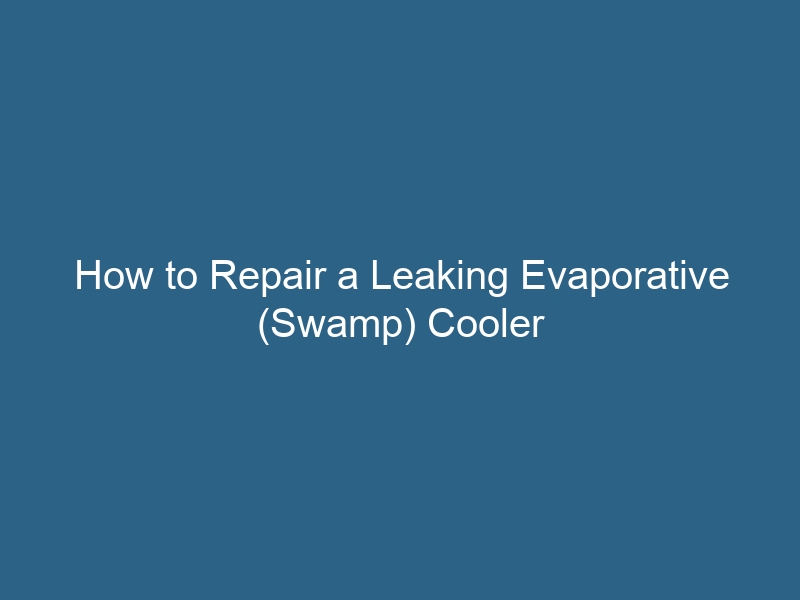Quck answer
To fix a leaking evaporative (swamp) cooler, follow these steps:
1. Turn off the power to the cooler and disconnect it from the water supply.
2. Locate the source of the leak, which is often due to a damaged float valve or cracked water line.
3. Replace the float valve if it is faulty or not sealing properly.
4. Repair any cracks or holes in the water line using a patch kit or by replacing the damaged section.
5. Check the drain plug and overflow pipe for any clogs or blockages and clear them if necessary.
6. Reconnect the water supply and turn on the power to test for any remaining leaks.
7. If the problem persists, it may be best to consult a professional for further assistance.
By following these steps, you can fix a leaking evaporative cooler and ensure it functions properly.
Evaporative swamp coolers are a cost-effective method of cooling a home in arid climates. Unfortunately, like most household appliances, issues can arise. Unless the evaporative cooler has been physically damaged, there are only six potential sources of leaks. Here are some simple suggestions for diagnosing and fixing a leaking swamp cooler.
Step 1: Power Off
Before starting any repairs, turn off the swamp cooler and either unplug it or switch it off at the breaker box. Additionally, wear safety goggles, long sleeves, and gloves to protect your eyes and hands from debris.
Step 2: Examine the Water Line
Inspect the water feed line. A common area for leaks in evaporative coolers is where the 1/4-inch copper water line enters the cooler housing. The three most likely issues in this area are:
- The compression nut needs to be tightened.
- The rubber gasket (washer) needs to be replaced.
- The float valve inside may be broken or loose and needs to be tightened or replaced.
Step 3: Check the Float Valve Inlet
Examine the float valve inlet. If the water leak appears to be coming from the water inlet at the float valve, the problem may be that water entering the reservoir is spraying outside of it. Lift up on the float arm to determine if all the water sprays into the reservoir. If not, adjust the float valve to direct the water further away from the reservoir’s edge.
Step 4: Adjust the Float Arm
Verify if the water level in the reservoir is above the top of the overflow pipe. If it is, simply bend the float arm to adjust the water level.
Step 5: Inspect the Pads
Check the front of the cooler at the pad. This common issue results in significant damage to the front screen cover of the cooler as rust and scale buildup gradually deteriorate it. Typically, this type of leak is caused by one of the following problems. Generally, repairs involve replacing either the pad itself or the distributor housing.
- The top of the pad is covered in scale, causing water to spray off of it.
- The front of the pad is covered in scale, forming mini-stalactites that create a bridge between the pad and the front screen of the cooler, allowing water to freely run out of the front.
- The distributor housing is warped and no longer fits snugly over the top of the cooler pad, resulting in water spraying or squirting out.
Step 6: Inspect the Drain Hole
Examine the drain hole at the bottom of the cooler for leaks. If water is leaking, ensure that the overflow pipe is securely screwed into place in the drain hole. Tighten the overflow pipe. If this doesn’t resolve the issue, you may need to replace the drain fittings and/or the overflow pipe.
Step 7: Check for Accumulation of Scale
Inspect if there is any leakage from the sides of the pad at the bottom of the cooler housing. If there is, check the amount of scale buildup on the pad sides and plastic inserts. If it appears to be excessive, you should clean or replace the pad. If the scale buildup is not excessive, ensure that the plastic side wall of the reservoir assembly is properly seated, with the base inside the lower reservoir wall.
Step 8: Examine the Reservoir
Examine the area beneath the water reservoir at the bottom of the cooler housing. Attempt to tighten or replace the drain fitting as it is the most cost-effective solution. Check if the water is overflowing from the front or back of the reservoir, and adjust the float valve if necessary. In all likelihood, the plastic reservoir liner is cracked and needs to be replaced.
Step 9: Replace the Reservoir Liner
Turn off the water supply. Remove the drain assembly and overflow pipe. Take out the pad, water distributor (which can be placed on top of the cooler), and the water pump (which can remain connected to the distributor). Unscrew the float valve from the cooler’s side.
Remove both plastic side walls and the bottom brace that holds the pad in place. Replace the large plastic reservoir liner that contains the system’s water. The plastic side walls may also need to be replaced.
Step 10: Fix a Metal Reservoir Pan
Drain the metal pan in an older evaporative cooler. Remove any rust by scrubbing it off. Patch any holes before applying a rust-resistant paint and/or sealant to the inside and outside of the pan. Allow it to dry completely before turning on the water and power.


